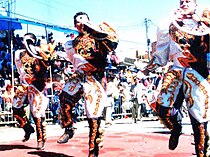Caporales: Difference between revisions
No edit summary |
MarshalN20 (talk | contribs) m Reverted edits by 72.229.154.212 (talk) to last version by Dodobird96 |
||
| Line 16: | Line 16: | ||
{{Culture of Bolivia}} |
{{Culture of Bolivia}} |
||
'''Caporales''' is a traditional Bolivian dance originating in the [[La Paz Department, Bolivia|Department of La Paz]], Bolivia |
'''Caporales''' is a traditional Bolivian dance originating in the [[La Paz Department, Bolivia|Department of La Paz]], Bolivia; danced as well in [[Peru]] and [[Argentina]] it was created and presented to the public for the first time in 1969 by the Estrada Pacheco brothers, who were inspired in the [[Afro-Bolivian Saya]] character of the ''Caporal'', a dance that belongs to the region of the [[Yungas]], Bolivia.<ref>{{Cite web |url= http://www.unet.univie.ac.at/~a9750175/spanisch/caporales.htm|title= Danzas autóctonas de Bolivia|publisher= http://www.unet.univie.ac.at|accessdate=2009-10-22 }}</ref> The dance, however, has a prominent religious aspect. One supposedly dances for The [[Virgin of Socavón]] (patroness of miners), or the [[Virgin of Candelaria]], and promises to dance for three years of one's life. Caporal or caporales today it is a folklore dance very popularly in the festivities of not only [[Bolivia]], but also [[Argentina]], [[Chile]], and [[Peru]]. |
||
In June 2011, through a Supreme Decree Caporales was declared Intangible Cultural Heritage of the Plurinational State of Bolivia. |
In June 2011, through a Supreme Decree Caporales was declared Intangible Cultural Heritage of the Plurinational State of Bolivia. |
||
Revision as of 04:27, 7 August 2014
| Caporales | |
|---|---|
| Stylistic origins | Afro-Bolivian Saya |
| Cultural origins | 1969 La Paz, Bolivia |
| Other topics | |
Music of Bolivia
 | |
| Part of a series on the |
| Culture of Bolivia |
|---|
 |
| History |
| People |
Caporales is a traditional Bolivian dance originating in the Department of La Paz, Bolivia; danced as well in Peru and Argentina it was created and presented to the public for the first time in 1969 by the Estrada Pacheco brothers, who were inspired in the Afro-Bolivian Saya character of the Caporal, a dance that belongs to the region of the Yungas, Bolivia.[1] The dance, however, has a prominent religious aspect. One supposedly dances for The Virgin of Socavón (patroness of miners), or the Virgin of Candelaria, and promises to dance for three years of one's life. Caporal or caporales today it is a folklore dance very popularly in the festivities of not only Bolivia, but also Argentina, Chile, and Peru.
In June 2011, through a Supreme Decree Caporales was declared Intangible Cultural Heritage of the Plurinational State of Bolivia.
There are many groups in the US that do these dances, such as Orgullo Boliviano, Alma Boliviana, San Simon Universitartio Virginia, FFBRI, San Simon USA, Sangre Boliviana, Fraternidad Folklorica Y Cultural Ruphay, and much more. A male caporal dress depicts an old Spanish military guard. Wearing heeled boots bearing large bells known as "cascabeles", a male dancer carries a hat in his left hand and a whip in his right(sometimes). Even some girls will dance in a male role; some may refer to them as "chinas" or "machas". A female caporal dress consists of a minidress with matching panties, skin-color pantyhose, fancy high-heeled shoes, and a round top hat pinned to her hair. The style and colours of the dress are maintained the same for both the men and women of a certain group, but can vary drastically between groups. Men and women usually dance separately in a progressive march style dance. Caporales is a dance where you jump a lot and is very active in this way.
The dance is often mistaken for the Afro-Bolivian Saya, a confusion partly due to popular Caporales song texts like the ones composed by the popular Bolivian group "Los Kjarkas"; this group makes many Bolivian songs. Also this is due to an international ballet version of Saya Caporal being danced as "Modern Saya" (see Afro-Bolivian Saya). However, there is a connection with the Saya: when the Caporales dance was created in the late 1960s by the Estrada Pacheco family, they claimed to have been inspired by the performance of some Afro-Bolivian dancers from the Yungas region. First the dance didn't have a proper music - the dancers adapted Huayños and Kullawadas before the first Caporales songs were composed. The rhythm is different from the Saya as well as the whole dance, which gradually became one of the most popular dances in Bolivia, especially appreciated by young people of the middle and upper class who form huge Caporales groups for Carnival, Gran Poder and other "entradas".
External links
References
- ^ "Danzas autóctonas de Bolivia". http://www.unet.univie.ac.at. Retrieved 2009-10-22.
{{cite web}}: External link in|publisher=
